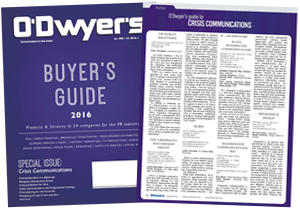|
|
I once had the unfortunate experience of kicking off a client engagement during crisis mode. The ink was still fresh on the contract as we huddled into a 72-hour crisis communications session. The experience produced an unintended benefit, however, in the sense that it gave my team incredible insight into the company’s leadership, culture and communication behaviors that became a key part of the long-term communications strategy we developed.
In the process, I realized that crisis communications isn’t dramatically different than regular communications. The timeline is simply intensified.
|
|
There’s no need for the latest crisis management guide or putting a crisis firm on speed dial, so long as you take the time each year to develop a thoughtful strategic communications plan and review social media guidelines. While there may be some extreme crisis situations that warrant more heavyweights, most of the time, these two resources will serve as a solid guide to organizations facing a crisis.
Instead of focusing on how to respond in moments of crisis, I’ve highlighted the four elements that ought to be in your current communications strategy that can double as your crisis response resource:
Delivering the right message to the right people
A good communications plan is informed by understanding where your key audiences live, which includes the various online channels where they communicate. A crisis typically requires very targeted communications to affected targeted audiences. Regardless of what you say to the market — in times of both crisis and normalcy — the rules are the same: figure out your message for each audience and deliver it via the appropriate channels.
Accessibility. If your audience can’t reach you, you’re dead in the water. Social channels like Facebook and Twitter are your 1-800 numbers that must be monitored constantly. If a crisis erupts on social media, consider the potential ripple effect and whether a response is warranted on other channels. Apply the same strategy for disseminating thought leadership content to your audiences, but in reverse. Key to successfully navigating these situations is a good social media policy that aligns with your organization’s culture and, most importantly, that employees embrace in good times and bad. It doesn’t have to be a 13-page narrative like The Smithsonian’s; it could be as simple as Zappos’ policy, which is “be smart.”
Operating with honesty and integrity
Transparency should be emphasized throughout a strategic communications plan and is critical to engaging with audiences, especially in difficult times. Inevitably all companies make mistakes and will need to utter the words “I’m sorry.” The more complex, delayed and detached the answer, the worse it makes the situation. Every bit of communication, from apologies to white papers, underscores the core values and integrity of your company. Don’t be tone deaf.
Listening and reacting
The easiest way not to be tone deaf in your communications is to listen. Listening is a core part of any marketing strategy — as a way to learn what your audience cares about, how they are responding to what you publish and how they feel about your company’s products or services. When a crisis hits, it simply elevates attention levels. If you’ve been doing the right things all along, you’ll likely face an audience that is more receptive to listening back.
If you find yourself facing a crisis without an active integrated marketing communications plan, Jay Baer has a great roadmap from his book The Now Revolution you can bookmark. Or maybe you need a crisis firm on speed dial. However, spending the time and resources upfront to develop a thorough communications plan can serve multiple benefits, save you valuable time and money in times of crisis, and might help you sleep better at night.
* * *
Cortney Stapleton is Partner and Professional Services Practice Leader at Bliss Integrated Communication.




 There’s a fine line between newsjacking and taking advantage, aka ambulance chasing. Our job as PR professionals is to tread it carefully.
There’s a fine line between newsjacking and taking advantage, aka ambulance chasing. Our job as PR professionals is to tread it carefully. PR firms need to be mindful of ways their work product may be protected by the attorney-client privilege whenever working with a client’s internal legal team or its external legal counsel.
PR firms need to be mindful of ways their work product may be protected by the attorney-client privilege whenever working with a client’s internal legal team or its external legal counsel. Manuel Rocha, former US ambassador and intenational business advisor to LLYC, plans to plead guilty to charges that he was a secret agent for Cuba.
Manuel Rocha, former US ambassador and intenational business advisor to LLYC, plans to plead guilty to charges that he was a secret agent for Cuba. CEO mentoring is an often-overlooked aspect of why CEOs are able to make good decisions, and sometimes make bad ones—all of which intersects with the role and duties of a board.
CEO mentoring is an often-overlooked aspect of why CEOs are able to make good decisions, and sometimes make bad ones—all of which intersects with the role and duties of a board.  How organizations can anticipate, prepare and respond to crises in an increasingly complex world where a convergent landscape of global challenges, threats and risks seem to arrive at an unrelenting pace.
How organizations can anticipate, prepare and respond to crises in an increasingly complex world where a convergent landscape of global challenges, threats and risks seem to arrive at an unrelenting pace.


 Have a comment? Send it to
Have a comment? Send it to 
No comments have been submitted for this story yet.